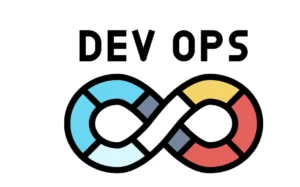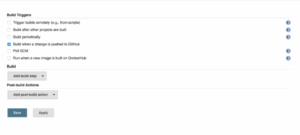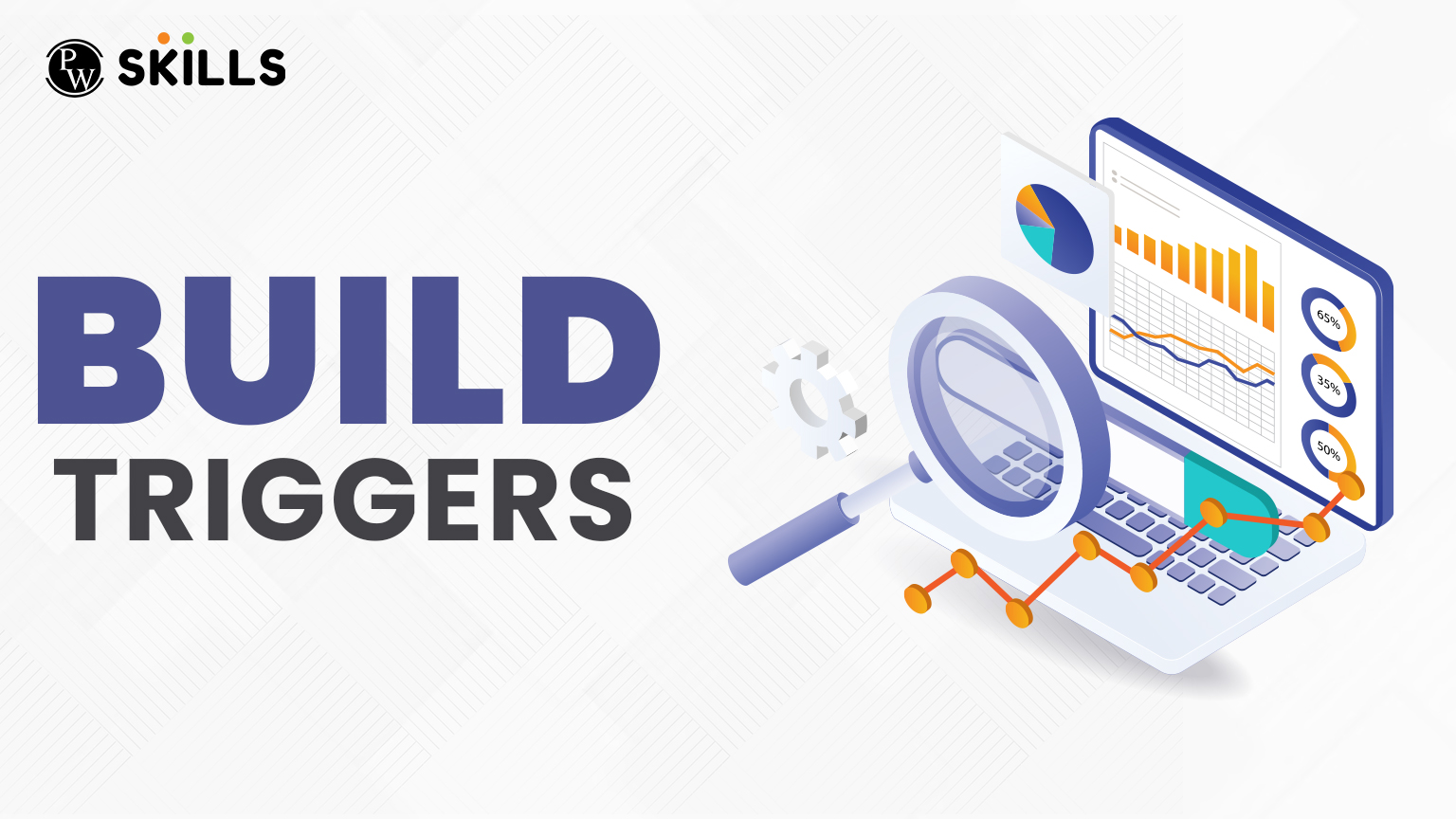In DevOps, Jenkins is ubiquitous and especially in companies where code is frequently deployed, such as startups, or is used to sustain hundreds of enterprise pipelines. However, by itself, Jenkins is naive and does not know when to work without the help of triggers.
These triggers serve as the backbone under the infrastructure: they run your pipelines when other conditions are successful, be they triggered by a change in code, a build run after several other jobs, or someone having bugged you with a message. And then again, if any of these out-of-the-ordinary conditions take place, your job is either untouched by Jenkins or exceedingly influenced in its expectations by your order: “Build Now.”
Let us walk you through all the Oracle of Delphian Build Triggers in this advice for 2025—starting with what they are and the types of Build Triggers and what they are good for, plus stuff like configuration, troubleshooting, best practices, and how you may be given an exam on this by the recruiters.

What Are Jenkins Build Triggers?
A build trigger in Jenkins is a condition that would require actions. Instead of having manual builds, Jenkins listens for these triggers, which, when activated, trigger automatically.
For easier explanations and greater understanding, I have put a comparison in real-world terms below:
- Manual build trigger acts like you flicking on the indoor fitting manually.
- A build trigger created using webhook (in this case, most times, pushing) is more like the one from your automatic driveway light; simply pass and turn on.
- Scheduled trigger: timer-activated, waiting at 7 PM every day (all things being equal).
This level of Build Triggers enables automation to take shape at its utmost power, with builds testing the software frequently and catching bugs as soon as they emerge, allowing more speed in release.
The Purpose of Build Triggers in Jenkins
The next frequent question would be: Why are build triggers in Jenkins? Well, the answer is trifurcated:
- to eliminate the tendency of slipping up on running builds;
- to provide instantaneous feedback and speed; and
- to ensure that the builds remain consistent in the way they execute.
These triggers are responsible for transforming Jenkins into a continuously integrating tool and not just a tool for sometimes integrating. In case people are interested, the everlasting power stays on the periphery.
Types of Jenkins Build Triggers (9 You Must Know in 2025)
Take a peek into these 9 types of Jenkins build triggers, which have been thoroughly dissected for you in this 2025 domain, along with examples, pros/cons, and certain best practices.
1. Manual Build Trigger
Definition: A manual build trigger is to kick start a job by pressing “Build Now” in Jenkins.
Use Cases:
Testing any fixes before going live on production.
Running a job occasionally for various purposes e,g., this whole job may be running in the background with newly compiled Maven projects doing some cleanup work from time to time to de-clutter our build environment.
The step by step for how to set up is:
- Go to job in Jenkins.
- Click Build Now from the dashboard.
Pros/Cons:
| Pros | Cons |
| Total control over builds | No automation |
| Useful for debugging | Prone to human error |
2. SCM Polling Build Trigger
Definition: Jenkins keeps checking the Git repo for changes
Steps for setup:
- Open job → Configure.
- Go to Build Triggers tab.
- Choose Poll SCM.
- Enter cron syntax (somewhere along the lines of H/5 * * * *).
Pros and Cons:
| Pros | Cons |
| Simple to set up | Can waste resources |
| Works without webhooks | Delayed builds possible |
3. Webhook (Push Event) Build Trigger
Definition: Trigger after source code push in GitHub, GitLab, or Bitbucket.
Examples: Connect GitHub webhook → http://jenkins-server/github-webhook/.
Pros and Cons:
| Pros | Cons |
| Real-time, instant builds | Needs network setup |
| Resource-efficient | Requires SCM configuration |
4. Scheduled Build Trigger (Cron Jobs)
Definition: Cron jobs used to run builds at fixed times.
E.g. Nightly regression tests 0 0 * * *.
Best For: Long, heavy builds.
5. Upstream/Downstream Build Trigger
Definition: Triggers jobs right after other jobs finish.
Example: After running App, deploy App.
Use for: Required for all multi-stage pipelines.
6. Remote Build Trigger
Definition: Use an API/URL for a job built on a different server setup.
Example: Run `”curl http://jenkins-server/job/MyJob/build?token=secret123″` over some API to meet your needs.
Best For: Monitoring systems or third-party apps.
![]() Join Our Devops & Cloud Computing Telegram Channel
Join Our Devops & Cloud Computing Telegram Channel
![]() Join Our Devops & Cloud Computing WhatsApp Channel
Join Our Devops & Cloud Computing WhatsApp Channel
7. Relay from Other Projects Build Trigger
Definition: When the outcome of an adjoining project becomes a trigger service for this job.
Difference From Upstream/Downstream: A higher level of selectivity.
8. Parameterized Build Trigger
Definition: Run builds based on user inputs, like choosing a branch or environment on which to perform the build.
Example: Select “staging” or “production” before triggering the manual build.
Pros and Cons:
| Pros | Cons |
| Flexible for QA teams | Setup complexity |
| Avoids duplicate jobs | Human error in parameters |
9. External Build Trigger Plugins
Definition: Trigger something with Jenkins from anywhere else, like Jira, Slack, Docker plugins.
Example: Fire a Jenkins build whenever a Jira ticket moves to “In Progress.”
Comparison Table: Build Triggers in Jenkins
| Trigger Type | Best For | Automation Level | Difficulty |
| Manual | Debugging, testing | Low | Easy |
| SCM Polling | Small teams | Medium | Medium |
| Webhook | Agile teams | High | Medium |
| Scheduled (Cron) | Compliance, nightly runs | Medium | Easy |
| Upstream/Downstream | Multi-stage pipelines | High | Medium |
| Remote | External integration | High | Medium |
| Project-based | Dependency handling | High | Medium |
| Parameterized | QA/testing flexibility | High | Medium |
| Plugin-based | Enterprise DevOps | Very High | Hard |
What Are Three Types of Triggers?
Most of the time when we talk about Jenkins Build Triggers, people expect the thinking behind the technicalities: What are the three types of triggers? Jenkins provides several possibilities for starting the build, but three of these categories (Manual Build Trigger, Scheduled Build Trigger, and Automated Build Trigger) are generally in use for every project setup. Each of those functionally assists in specific ways in the CI/CD pipeline.
1. Manual Build Trigger
Manual Build Triggering is the simplest way of starting a Jenkins job. One logs on to Jenkins with an account that has the needed permissions and then clicks the “Build Now” button, effectively starting the job.
Use case:
- Sanity testing of new jobs
- Debugging pipelines before actual automation
- One-off tasks
Advantages:
- Full control over whether a build is started
- Quick way to validate changes
Disadvantages:
- Cannot sustain very frequent executions
- Involves human intervention
2. Scheduled Build Trigger
The Scheduled Build Trigger is basically about setting a fixed time or frequency using cron syntax. For project teams that want their builds to happen automatically at set intervals without manual intervention, this can be a great fit.
Use case:
- Nightly regression tests
- Weekly reporting jobs
- A heavy output job during off-hours
Advantages:
- Predictable
- Reduces human dependency
Disadvantages:
- It may only trigger on every hour while no code is being pushed or pulled.
- Might be confusing to new hires with zero knowledge of cron syntaxes
Example Table – Cron Syntax for Build Triggers
| Cron Expression | Meaning | Example Usage |
| H 2 * * * | Every day at 2 AM | Nightly build |
| H/15 * * * * | Every 15 minutes | Continuous monitoring |
| H 12 * * 1 | Every Monday noon | Weekly report build |
3. Automated Build Triggers (Event-Driven)
Automated Build Triggers are revolutionary: instead of depending on people or hard-and-fast schedules, Jenkins acts on events-launching a new code commit, a pull request, or a webhook care of GitHub.
Use Case:
- CI pipelines
- Trigger builds on every code push
- Connection with GitHub, GitLab, or Bitbucket
Benefits:
- Fast feedback to devs
- Very Much Auto
- Agile-DevOps-Compatible
Disadvantages:
- Overwhelming amounts of builds if poorly handled
- Requires nice webhook set up
Quick Recap – The Three Triggers
If you still wanted to ask, “What are the three trigger types?” in Jenkins, here is the summary:
- Manual Triggering of Builds → a one-time or testing build
- Scheduled Build Triggers → for very predictable and routine times
- Automated Build Triggers → for real-time CI/CD pipelines
Every kind of Build Trigger comes with a purpose, and while they’re generally not supposed to be combined, smart teams will get around to it.

Step-by-step: How to Set Up Build Triggers in Jenkins
- Go to your job in Jenkins → Configure.
- Scroll to Build Triggers section.
- Select the desired trigger (for example Poll SCM).

- Fill in cron expression or webhook details.
- Save and test your configuration.
Common Mistakes with Build Triggers
| Mistake | Why It’s a Problem | Fix |
| Using polling instead of webhooks | Wastes resources | Prefer webhooks for event-driven builds |
| Too many scheduled jobs | Overloads servers | Spread out timings, use pipelines |
| Unsecured remote triggers | Security risk | Always use tokens and HTTPS |
| Overusing parameters | Confuses users | Keep builds simple, document variables |
Mini Case Study: Using Build Triggers in a Real Team
For a fintech startup building a payments app, this is how they set up Build Triggers in Jenkins:
- Developers push to GitHub → Tests unit through webhook trigger.
- At midnight → This trigger does full regression test.
- “Build App” job → Triggers “Deploy App” job because of upstream trigger.
- Control for QA → Parameterized trigger has two testing environments, “staging,” and “production.”
This combination gives them speed, security, and flexibility.
Interview Questions & Answers on Build Triggers
- What are the Build Triggers used for in Jenkins?
Answer:
The Build Triggers are to automate that whereas the developer would be supposed to run his job manually each time, with the trigger, such a build is being done depending on conditions which may include code commits, schedules in time, scripts from outside, or events from the pipeline itself. Thus, it makes productivity high, with less human error, and helps in continuous integration.
- What are the three main types of triggers available in Jenkins Build?
Answer:
Three common build trigger types are:
SCM Trigger (Poll SCM/Webhooks) – Starts a build when a commit is done into the source code repository.
Scheduled Trigger (Cron Jobs) – A build job is run at a predetermined time, for instance, nightly builds.
Manual Trigger – Triggers the builds by the developers at the specific time of need usually for debugging purposes or during a special release.
- What is the manual Trigger of Build and when is it used?
Answer:
It means the job does not start automatically; it is triggered by a developer by clicking “Build Now.” It is used for testing new config changes, verifying bug fixes, or deploying hotfixes that should not wait for automated triggers.
- How do you configure Build Triggers in Jenkins?
Answer:
Open your Jenkins job to configure Build Trigger:
Enter a trigger of your choice like Poll SCM, GitHub hook trigger, or schedule through the VCRON.
Save and test using code push or wait for the schedule.
- What is the difference between Poll SCM and Webhooks as Build Triggers?
Answer:
Poll SCM checks the repository at intervals for changes. It could pile load on Jenkins server if polling too frequently.
Webhooks notify Jenkins of change directly so that builds are faster and more efficient.
Both are used as Build Triggers for continuous integration, but in modern CI/CD pipelines, the preferred manner is through webhooks.
- Can more than one Build Trigger be used in one Jenkins case?
Answer:
Yes. You can tie together different Build Triggers to one job. For instance, a pipeline can automatically run if SCM commits are done but also scheduled for a nightly build. It gives teams the flexibility to combine the urgent with the routine checks.
- What building triggers are for Continuous Integration?
Answer:
Build triggers enable Continuous Integration, where each code change, pull request, or scheduled build is automatically tested and deployed. It minimizes integration problems, gives quick feedback to developers, and helps keep stable builds within the lifetime of development.
- What are the different common mistakes people make in setting up the Building Triggers?
Answer:
Using Poll SCM very frequently, thus adding to the load on the Jenkins server.
Not properly setting up the credentials for GitHub/GitLab triggers.
Ignoring time zones in scheduled triggers.
Have manual builds but very over-depend on the latter than on automating.
- How do you debug if the Build Trigger has not worked out?
Answer:
Check job configuration in Jenkins under Build Triggers.
For SCM, check if webhook is delivered in GitHub/GitLab.
View logs in Jenkins (Manage Jenkins > System Log).
Test with “Build Now” manually to ensure job runs correctly.
- Why are Build Triggers necessary for DevOps engineers?
Answer:
For DevOps engineers, Build Triggers would automate repetitive tasks through making it speedier on delivery and ensuring implemented code gets tested as soon as it gets modified. Builds would, without those triggers, rely upon manual effort and would ultimately slow down development and increase opportunities for errors.
Best Practices for Using Build Triggers
- Well document all triggers in your project README.
- Keep an eye on the logs in Jenkins so that you see if triggers fire correctly.
- Ensure secure remote triggers with strong tokens.
- Prefer event-based over time-based triggers.
- Review plugins on a regular basis.
Build Triggers Are the Lifeblood of Jenkins in 2025
Jenkins really defines the pipelines flows as continuous, which build triggers make it true. From manual clicks to automating webhooks and enterprise plugins, designing workflows that fit your exact needs becomes possible.
For students, building the understanding of triggers leads to confidence in CI/CD. For professionals, mastering them allows for better productivity and reduced risk in deployments. In both cases, build triggers are the key to using Jenkins like a pro.
Also Read:
- What is DORA Metrics in DevOps, and Why It’s the Key to Success
- Lean Principles Introduction in DevOps
- DevOps Team Setup 101 – Explore Powerful Future of Tech
- 12 Types of Cloud Security Tools & 5 Open Source Tools
Boost Your Career with PW Skills DevOps Course
The DevOps Course at PW Skills turns out to be a very industry-oriented course where one gets to work on real projects. The Devops course is aimed more at students new to DevOps and professionals scaling their careers since, apart from learning the use of these tools, students actually build systems that work in production. Join now to future-proof yourself.
Yes, Jenkins integrates directly using webhooks or SCM polling. Manual requires human input; scheduled runs automatically at defined times. Most are, but remote triggers must be secured with tokens and HTTPS. Yes, plugins can augment Jenkins with triggers from, for instance, Jira, Docker, and Slack. Manual, scheduled, or webhook triggers are the simplest entry points.Build Triggers FAQs
Can Jenkins Build Triggers work with cloud SCMs like GitHub, GitLab, and Bitbucket?
What is the difference between scheduled and manual triggers?
Are build triggers secured?
Can plugins add new triggers in Jenkins?
Which triggers are best to use when starting out?

